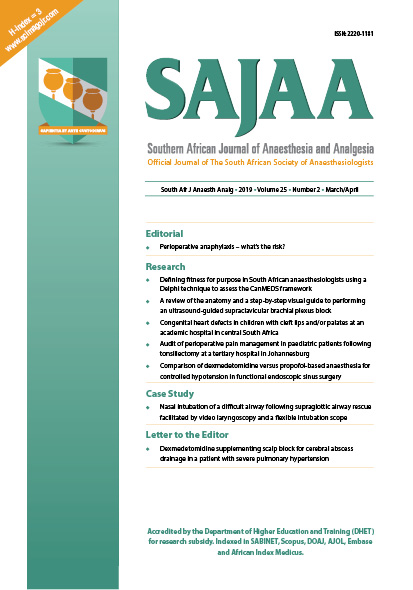Audit of perioperative pain management in paediatric patients following tonsillectomy at a tertiary hospital in Johannesburg
Keywords:
Anaesthesia, paediatric, tonsillectomy, pain management, auditAbstract
Background: Adenotonsillectomy remains one of the most frequently performed surgical procedures in children. Despite improvements in anaesthetic and surgical techniques, severe pain is reported in as many as 25–50% of children. Pain assessment and knowledge of drug pharmacodynamics and pharmacokinetics in the paediatric patient, is a prerequisite for optimal care. Much has been written on perioperative pain management following tonsillectomy. However, no consensus has been reached on what the ideal analgesic regimen should be. This audit is a review of current practice at Chris Hani Baragwanath Academic Hospital. It aims to identify problems and develop possible solutions to improve anaesthetic practice.
Methods: A prospective, contextual, descriptive study design using a data collection sheet was used on paediatric patients presenting for tonsillectomy.
Results: Eighty-five patients aged three to 12 years of age, with ASA grading I or II, were enrolled in the study. The choice of anaesthetic was variable with a combination of simple analgesics, opioids and adjuvants. This affected postoperative pain scores. Snare dissection and monopolar cautery haemostasis, was the standard surgical technique. Surgical seniority influenced the duration of tonsillectomy, with an effect on postoperative pain scores.
Conclusions: Audits are necessary to evaluate what resources are needed to optimise care. The occurrence of pain after tonsillectomy continues to be poorly managed. Appropriate premedication and fasting of clear fluids for no more than two hours, needs to be introduced. Where possible surgical technique should involve bipolar cautery and be limited to less than 45 minutes. A preemptive, multimodal, opioid-sparing anaesthetic should be routinely practised.
Downloads
Published
Issue
Section
License
By submitting manuscripts to SAJAA, authors of original articles are assigning copyright to the SA Society of Anaesthesiologists. Authors may use their own work after publication without written permission, provided they acknowledge the original source. Individuals and academic institutions may freely copy and distribute articles published in SAJAA for educational and research purposes without obtaining permission.
The work is licensed under a Creative Commons Attribution-Non-Commercial Works 4.0 South Africa License. The SAJAA does not hold itself responsible for statements made by the authors.

